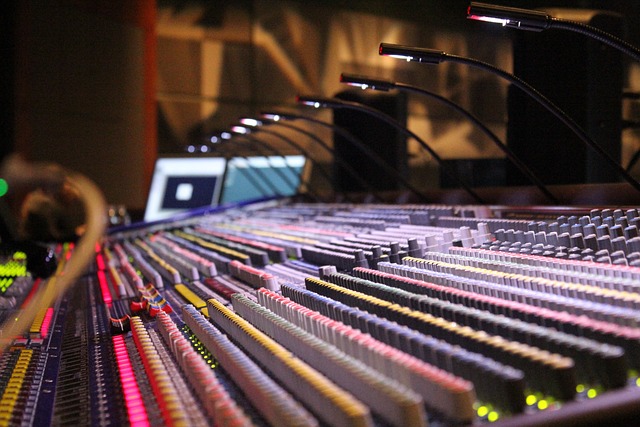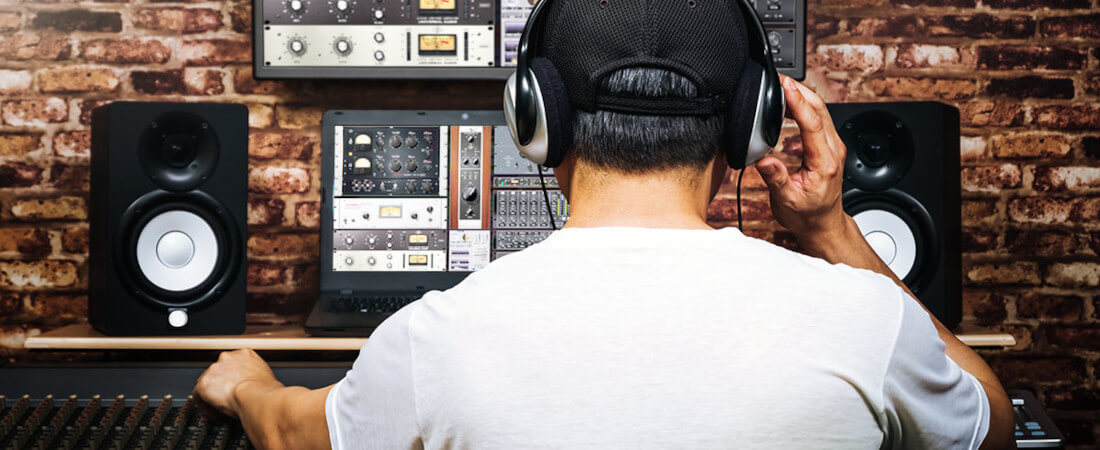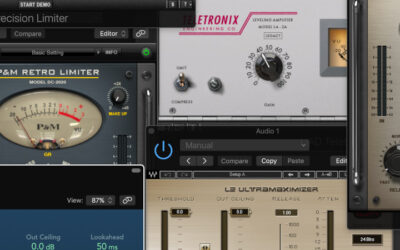EQ AND COMPRESSION
In music production and audio engineering, EQ and compression are two essential tools used to shape and manipulate the sound of a recording or mix.
EQ, short for equalization, involves adjusting the balance of frequencies within an audio signal. An equalizer allows you to boost or cut specific frequency ranges to enhance or reduce certain elements of a sound. EQ can be used to shape the tonal characteristics of individual instruments, vocals, or an entire mix. For example, you can use EQ to boost the presence of vocals in a mix, reduce excessive bass frequencies in a guitar, or add brightness to a snare drum. EQ is typically applied using a graphic EQ, parametric EQ, or shelving EQ.
Compression, on the other hand, is a dynamic processing technique used to control the dynamic range of an audio signal. Dynamic range refers to the difference between the loudest and softest parts of a sound. Compression helps to even out these levels by reducing the volume of the louder portions and increasing the volume of quieter sections. It essentially reduces the dynamic range, making the audio more consistent and controlled. Compression is useful for controlling the levels of individual tracks, smoothing out the overall mix, and adding sustain to instruments. It is commonly used on vocals, drums, guitars, and other instruments that exhibit wide variations in volume. Compressors come in various types, including analog and digital compressors, and offer controls for adjusting parameters such as threshold, ratio, attack, release, and makeup gain.
Both EQ and compression are powerful tools for audio engineers and producers to shape and enhance the sound of a recording or mix. They can be used in combination to achieve the desired tonal balance, clarity, and dynamics in a musical production.
Using EQ in the mixing stage
Using EQ during the mixing process offers several benefits in shaping the overall sound and achieving a balanced mix. Here are some of the main advantages:
- Frequency balance: EQ allows you to adjust the levels of different frequency ranges, such as bass, midrange, and treble. By carefully balancing these frequencies, you can ensure that each instrument or element in the mix has its own space and clarity. This prevents certain elements from overpowering others and helps create a more cohesive and pleasant listening experience.
- Clarity and separation: EQ helps to enhance the clarity and separation of individual instruments and elements within the mix. By removing unwanted frequencies or resonances that can cause muddiness or masking, you can make each element stand out more clearly and occupy its own sonic space. This improves the definition and intelligibility of the mix.
- Correcting problematic frequencies: Sometimes, certain instruments or vocal tracks may have frequency imbalances or resonances that need to be addressed. EQ can be used to reduce or eliminate these problematic frequencies, such as removing a harsh high-frequency sizzle from cymbals or reducing a boomy low-frequency buildup in a bass guitar. By addressing these issues, you can improve the overall sound quality and prevent certain frequencies from dominating the mix.
- Tonal shaping and character: EQ allows you to shape the tonal characteristics of individual tracks or the overall mix. You can boost or cut specific frequencies to add warmth, brightness, or presence to instruments and vocals. This gives you creative control to shape the sonic character of your mix and achieve the desired tonal balance.
- Correcting room and microphone deficiencies: During the recording process, the room acoustics and microphone characteristics can introduce certain colorations or anomalies. EQ can be used to compensate for these deficiencies and achieve a more accurate representation of the sound. For example, you can reduce excessive room resonances or compensate for a microphone that accentuates certain frequencies.
Remember, the key is to use EQ judiciously and with a purpose. It’s important to make subtle adjustments and use your ears to evaluate the impact of EQ changes, ensuring that the overall mix remains balanced and natural-sounding.
Using EQ in the mastering stage
Using EQ in the mastering stage involves making final adjustments to the overall frequency balance of a stereo mix. While the primary focus of EQ in the mastering process is to enhance the mix as a whole, the specific goals may vary depending on the material and desired outcome. Here are some common applications of EQ during mastering:
- Tonal balance: The mastering engineer aims to achieve a balanced frequency response across the entire mix. By using EQ, they can address any remaining tonal imbalances, such as excessive bass or harsh highs. This helps ensure that the mix translates well across different playback systems and maintains a pleasing tonal character.
- Corrective EQ: Mastering EQ can be used to address any subtle frequency issues that may have been missed during the mixing stage. This may involve taming resonances, reducing masking between instruments, or addressing frequency buildups. The goal is to refine the mix and optimize its overall clarity and cohesiveness.
- Enhancing or de-emphasizing certain elements: EQ can be used to enhance specific elements within the mix. For example, if the vocals need more presence, a gentle boost in the vocal range can be applied. Similarly, certain instruments or elements can be subtly emphasized or de-emphasized to create a desired focus or atmosphere.
- Matching the spectral balance: If a series of tracks is being mastered for a cohesive album, EQ can be used to ensure a consistent spectral balance across the songs. This helps create a unified sonic experience and ensures smooth transitions between tracks.
- Contouring the overall sound: In some cases, the mastering engineer may use broad EQ adjustments to shape the overall sound of the mix, adding a touch of warmth, brightness, or character. These adjustments are typically made with careful consideration to preserve the integrity of the original mix and artistic intent.
It’s important to note that mastering EQ should generally be approached with subtlety and finesse. Small adjustments are often more effective than drastic changes. A skilled mastering engineer uses their experience, critical listening skills, and an understanding of the target genre and client’s preferences to make informed decisions about the appropriate application of EQ.
Using compression in the mixing stage
Compression is a commonly used tool during the mixing stage of audio production. Its primary purpose is to control the dynamic range of individual tracks, shape the overall mix, and achieve a more balanced and polished sound. Here are some ways compression is applied during the mixing stage:
-
Dynamics control: Compression helps to even out the levels of individual tracks by reducing the dynamic range. It can bring down the loud peaks and increase the volume of softer sections, resulting in a more consistent and controlled sound. This is particularly useful for instruments with wide dynamic ranges, such as vocals, drums, and guitars.
-
Taming transients: Transients are the initial, brief bursts of energy in a sound, such as the attack of a drum hit or the pluck of a guitar string. Compression can be used to tame excessive transients that may cause certain elements to stick out too prominently in the mix. By reducing the attack or transient level, compression can help create a smoother and more balanced mix.
-
Adding sustain and presence: Compression can enhance the sustain and presence of instruments, vocals, or the overall mix. By using longer attack times and higher ratios, compression can bring up the sustain and make the sounds appear more upfront and present in the mix.
-
Gluing the mix: Compression is often used on the mix bus or subgroups to create cohesion and glue the individual elements together. By applying gentle and transparent compression across the entire mix, it can help blend the instruments and vocals, making them feel more unified and cohesive.
-
Sidechain compression: Sidechain compression is a technique where the compression is triggered by the audio signal from another source, typically the kick drum or bass. It is commonly used to create space for certain elements in the mix, such as ducking the backing instruments when the vocals come in, or to achieve a pumping effect in electronic music genres.
It’s important to note that compression should be used judiciously and with careful listening. Each track may require different settings based on its characteristics and role in the mix. The goal is to enhance the musicality, balance, and overall impact of the mix, while maintaining a natural and transparent sound.
Using compression in the mastering stage
Using compression in the mastering stage offers several key benefits for finalizing and enhancing the overall mix. Firstly, compression helps to control the dynamic range of the mix, ensuring that the louder sections are controlled and the quieter sections are brought up, resulting in a more balanced and consistent sound. Secondly, compression allows the mastering engineer to shape the tone and texture of the mix, emphasizing or reducing certain elements to achieve a desired tonal balance. This helps to enhance the clarity and impact of the mix. Thirdly, compression can add a sense of cohesion and glue to the mix, bringing together the individual tracks and elements, resulting in a more polished and unified sound. Lastly, compression helps to optimize the mix for different listening environments and platforms, ensuring that it translates well across various playback systems.
Mixing In Key Or Harmornic Mixing
Mixing in key refers to the practice of aligning the musical elements in a mix to ensure they are harmonically compatible. It involves considering the key or musical scale of each individual track and making conscious decisions...
Using a reference track to improve your mixes
» Setting a benchmark » Developing a better ear » Improving your techniques » Avoid common mistakes Mixing is a complex process that involves balancing the different elements of a track to create a cohesive and balanced sound....
Using a limiter or clipper in music mixing and production
WHEN AND HOW TO USE A LIMITER MIXING MUSICAudio mixing and production involve a range of techniques and tools to shape the sound of a track. One essential tool in this process is the limiter or clipper. A limiter or clipper is...
Extras
Blog
Other News
Contact Page
About Us




